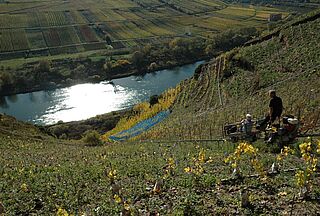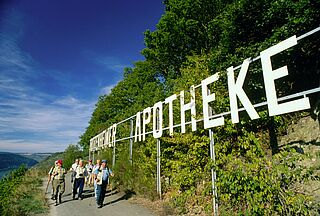Marienburg
Kendte vinmarker
Marienburg: Kulturweg Kanonenbahn (Cannon Railroad Cultural Trail)
At Cochem, some 50 km/30 miles southwest of the Mosel Rivers confluence with the Rhine at Koblenz, the Mosel begins a series of spectacular loops as it snakes its way toward Zell, Bernkastel and Trier.
One of the most impressive and narrowest (less than 300 m/984 ft wide) is the Zeller Hamm, where the Mosel nearly encircles the vine-clad hill “Petersberg” as it loops for some 14 km/9 miles from Alf and Bullay to Zell, Briedel and Pünderich. Majestically perched atop the hill’s forested summit is the Marienburg, which has been home to a convent and fortresses over the centuries. The terrace and observation deck afford a fantastic panoramic view of the loop and the vineyards on both sides of the river.
Marienburg is the namesake of the site that straddles the Mosel at Pünderich. The vineyards on the right (east) bank of the river at Pünderich are somewhat sloping and face west; theRiesling vines on the left (west) bank of the river are quite steep, sweeping up to an altitude of 230 m/755 ft, and face east, south and southwest – depending on the curve of the hillside. Stony, weathered slate predominates, sometimes mixed with loam. In all, the site is not quite 100 ha/250 acres in size.
Pündericher Marienburg Riesling wines – or the Mosel Rieslings from neighboring villages, such as Alf, Bullay, Briedel or Reil, are not likely to be found in export markets, nor far beyond the borders of their origin. All the more reason to come visit – to sample the local wines, explore a typical Mosel landscape by bicycle or on a vineyard hike, and enjoy the warm hospitality of vintners at wine festivals and/or in their wine pubs and holiday quarters.
Zell, on the other hand, has achieved an international following thanks to volume production and exports of its “Schwarze Katz” (black cat) wine. With 4.5 million vines equal to an area of ca. 627 ha/1,550 acres, Zell is one of the largest wine-growing communities of Germany. “Zeller Schwarze Katz” is the collective name of Zell’s 16 individual vineyard sites. The picturesque “black cat” labels and relatively easy-to-pronounce “Schwarze Katz” (shvartz´ eh kahtz) made for a marketing success and helped put Zell “on the map” in export markets as a popular German generic wine (cf. Piesporter Michelsberg, Niersteiner Gutes Domtal). While these generics are no longer particularly in vogue with wine lovers who seek more exclusive, tailor-made wines with terroir characteristics, they are popular with vacationers...it’s easy to enjoy even a simple wine right where it was produced.
To explore this section of the Mosel Valley on foot, you can follow the signposted “Cannon Railroad Cultural Trail” that runs 8.5 km/5miles between Bullay and Reil. It takes in a hike through the steep site Pündericher Marienburg, the Marienburg (with its vistas), and features historical railroad architechture en route, such as the first (1877) double-decker bridge (for railroad and autos) at Bullay and the “hillside viaduct” (1880) with 92 arches covering a span of 786 m/ 2,580 ft through the vineyards, complete with massive tunnels, between Reil and Bullay.
Opened in September 2005, the trail is dedicated to the “Kanonenbahn” (cannon railroad), a railway stretch between Berlin and Metz (in Lorraine, formerly German, today French) – a strategically important factor in quickly shipping troops and supplies to the western front during the first and second world wars. In time, local railway lines were built to connect wine-growing villages along the Mosel with this main line – which greatly helped wine-growers to inexpensively transport their wines (compared with expensive boat transport), and thus helped improve their economic status.
For those who wish to hike the entire trail (ca. 23 km/14-miles) covering both sides of the river, i.e. a circular route, it is easy to stop in for a glass of wine or meal, or overnight in, one of the wine villages on the right side of the Mosel, or at Marienburg or in Alf on the left side of the river.
Tips for Tourists:
Marienburg:
In the course of the past millennium, the Marienburg has been the site of a castle, an Augustinian convent (1146–1515), and a fortress that was destroyed by the French in 1650 but rebuilt in ca. 1700 in Baroque style. The former monastery church (consecrated in 1157) bears witness to several building periods: the nave dates from the 12th century; the late Gothic chancel from the 2nd half of the 15th century; and the upper masonry of the nave with its oval windows stems from the 18th century.
55 rooms (simple accommodations: no room telephone or TV; not all rooms have private bath/WC – request when booking) at low prices (€30 per person, incl. breakfast). Restaurant on the premises. Wonderful terrace with views. No credit cards. All rooms no smoking. Guesthouse open year-round; terrace open May–October.
Marienburg, 56856 Zell/Mosel
Tel: +49 6542 93680
Fax: +49 6542 1591
Schloss Zell:
Built 1530–1536 by the elector of Trier, Richard von Greiffenclau, as thanks for Zell citizens’ help in overcoming an uprising in Trier (seat of the elector). In 1803, in the aftermath of secularization, the property was privatized and has been a guesthouse (on and off) ever since. For the past decade, the hotel has been run by the Schneider family, who completely renovated the castle in 1995/96.
13 individually decorated rooms, some are located in the two towers. Standard rooms for €60 (single)–€90 (double); larger rooms for €70 (single)–€110 (double). Price includes breakfast. Restaurant in the vaulted cellar or on the terrace. Credit cards accepted. All rooms no smoking (but two rooms have balconies). Closed January and February.
Hotel Schloss Zell, Schloss Strasse 8a, 56856 Zell/Mosel
Tel: +49 6542 98860
Fax: +49 6542 988690
www.schlosszell.de
Burg Arras – Hotel, Restaurant, Museum:
Former Roman bulwark, later built as a castle (950) and became home to the Knights of Arras. It was destroyed by the French in 1689 and rebuilt in ca. 1900. Today, it is the only “castle hotel” in the Mosel Valley. Operated by the Keuthen family.
From the keep (936), the oldest defense tower on the Mosel, there is a panoramic view of three valleys. The dungeon, with a torture chamber, can also be visited. The knights’ hall and the Meissen Room house part of a small museum with medieval armour and weapons, and exhibits related to the history of the Mosel.
The museum is open daily, from March through December.
10 well-appointed rooms. Prices vary according to size of room: €95–€125 (single), €130–€170 (double) – surcharge for one-night stay on Fri. or Sat. Price includes breakfast. Restaurant (specialty: game). Terrace. No credit cards. All rooms but one no smoking. Closed January and February.
Hotel Burg Arras, 56859 Alf/Mosel
Tel: +49 6542 22275
Fax: +49 6542 2595
www.arras.de
Mosel cruises, May through October:
www.moselfahrplan.de
www.moselschifffahrt.de
Large wine festival (with parade) celebrating “Zeller Schwarze Katz” in late June.
Many thanks to Frau Petra Prem, director of Tourist-Information Zeller Land, Zell/Mosel, for background information and the illustration. For additional details, see: www.zellerland.de


